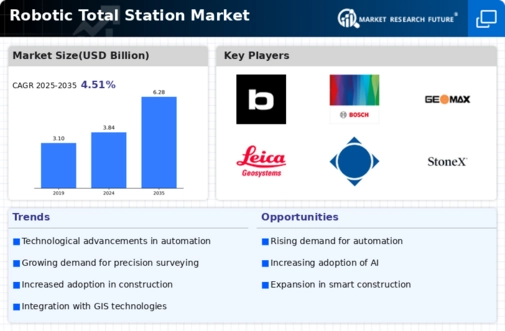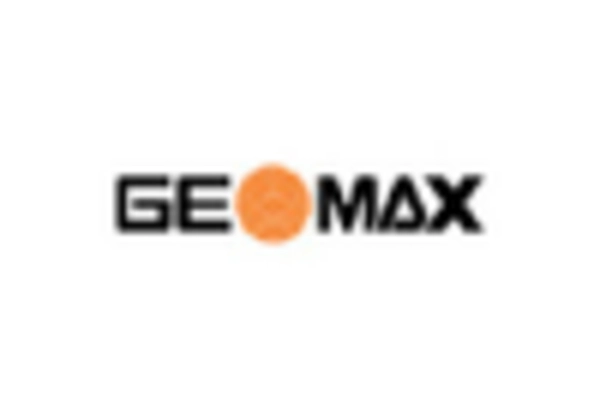Integration of Smart Technologies
The integration of smart technologies into the Robotic Total Station Market is reshaping the landscape of surveying and construction. The incorporation of Internet of Things (IoT) capabilities allows for seamless data sharing and real-time monitoring, enhancing collaboration among project stakeholders. This trend is particularly relevant as the construction industry increasingly embraces digital transformation. The ability to connect robotic total stations to cloud-based platforms facilitates better data management and analysis, leading to more informed decision-making. Market analysis reveals that the demand for smart solutions in construction is on the rise, with robotic total stations playing a pivotal role in this evolution. As firms prioritize efficiency and data-driven strategies, the integration of smart technologies is expected to be a key driver of growth in the Robotic Total Station Market.
Emphasis on Training and Skill Development
The Robotic Total Station Market is also shaped by the emphasis on training and skill development within the surveying and construction sectors. As robotic total stations become more sophisticated, the need for skilled operators who can effectively utilize these advanced tools is paramount. Educational institutions and training programs are increasingly focusing on equipping professionals with the necessary skills to operate robotic total stations proficiently. This trend is crucial for ensuring that the workforce is prepared to meet the demands of a rapidly evolving market. Market Research Future suggest that as more professionals gain expertise in using robotic total stations, the overall adoption rate is likely to increase. Consequently, this emphasis on training and skill development is expected to contribute positively to the growth trajectory of the Robotic Total Station Market.
Growing Focus on Infrastructure Development
The Robotic Total Station Market is significantly influenced by the growing focus on infrastructure development across various regions. Governments and private entities are investing heavily in infrastructure projects, including roads, bridges, and urban development. This increased investment necessitates precise surveying and mapping solutions, which robotic total stations provide. The market is projected to benefit from this trend, as the demand for accurate and efficient surveying tools rises in tandem with infrastructure projects. Recent reports indicate that infrastructure spending is expected to reach unprecedented levels, further fueling the need for advanced surveying equipment. As a result, the Robotic Total Station Market is likely to experience substantial growth, driven by the ongoing commitment to enhancing infrastructure capabilities.
Rising Demand for Automation in Construction
The Robotic Total Station Market is witnessing a notable increase in demand for automation within the construction sector. As construction projects become more complex, the need for efficient and accurate surveying solutions has intensified. Robotic total stations offer automated features that allow for remote operation, reducing the need for manual labor and minimizing human error. This shift towards automation is reflected in the growing number of construction firms investing in robotic total stations to enhance productivity and project timelines. Market data indicates that the construction industry is expected to expand significantly, which will likely drive the adoption of robotic total stations. Consequently, this trend suggests a robust future for the Robotic Total Station Market, as companies seek to leverage technology to streamline operations and improve overall project outcomes.
Technological Advancements in Surveying Equipment
The Robotic Total Station Market is experiencing a surge in technological advancements that enhance the precision and efficiency of surveying tasks. Innovations such as integrated GPS, advanced software algorithms, and real-time data processing capabilities are transforming traditional surveying methods. These advancements not only improve accuracy but also reduce the time required for data collection and analysis. According to recent data, the market for robotic total stations is projected to grow at a compound annual growth rate of approximately 7.5% over the next five years. This growth is driven by the increasing adoption of automation in construction and civil engineering projects, where precision is paramount. As a result, the demand for robotic total stations equipped with cutting-edge technology is likely to rise, further propelling the market forward.

















Leave a Comment